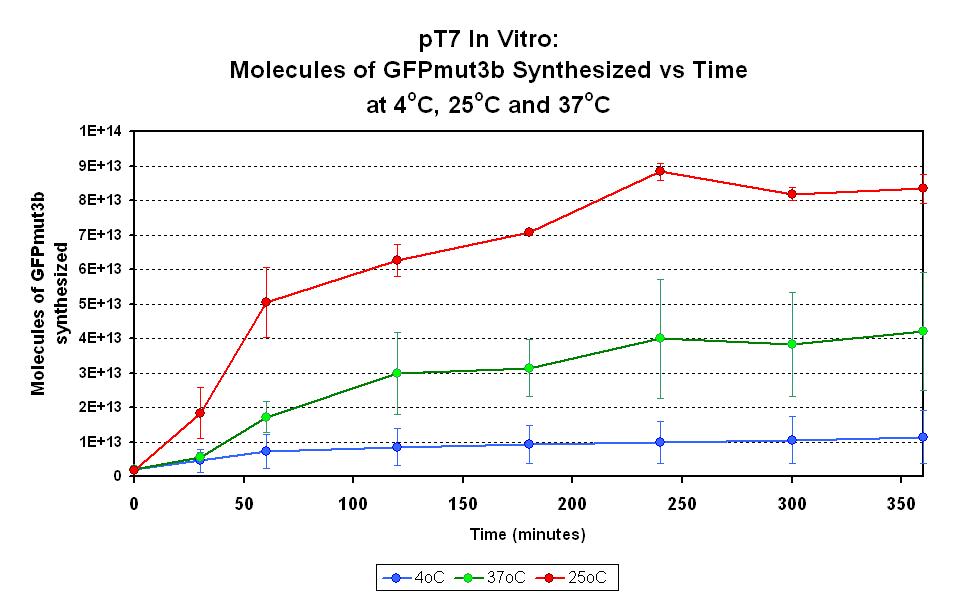Imperial/Wet Lab/Results/Res1.9
From 2007.igem.org
m (→Results) |
m |
||
| (11 intermediate revisions not shown) | |||
| Line 1: | Line 1: | ||
| + | {{Template: IC07navmenu}} | ||
| + | <br clear="all"> | ||
| + | __NOTOC__ | ||
| + | |||
= ''In vitro'' Testing of pT7-GFPmut3b Construct= | = ''In vitro'' Testing of pT7-GFPmut3b Construct= | ||
| - | |||
==Aims== | ==Aims== | ||
| - | To determine if the '''pT7-GFPmut3b''' | + | To determine if the '''pT7-GFPmut3b''' construct works ''in vitro''. In addition we wish to characterize this construct's response at varying temperatures. |
| - | + | ||
| - | + | ||
==Materials and Methods== | ==Materials and Methods== | ||
| - | + | Link to [[Imperial/Wet_Lab/Protocols/Prot1.9|Protocol]] | |
| - | + | ||
| - | + | ||
==Results== | ==Results== | ||
| Line 17: | Line 16: | ||
|} | |} | ||
'''Controls:''' | '''Controls:''' | ||
| - | *Negative Control-pT7 construct | + | *Negative Control-pT7 construct |
'''Constants:''' | '''Constants:''' | ||
*DNA Concentration - 4µg | *DNA Concentration - 4µg | ||
| Line 23: | Line 22: | ||
'''Raw Data''' | '''Raw Data''' | ||
| - | *[[media:PT7.xls| Excel File of Raw Data]] | + | *[[media:IC 2007 PT7.xls| Excel File of Raw Data]] |
==Discussion== | ==Discussion== | ||
Figure 1. shows us that the pT7-GFPmut3b synthesizes over time for all the temperatures tested. When the three temperatures are compared it is clear that 4°C is the minimum temperature for expression and that 25°C is the maxiumum. Interestingly 37°C is not the maximum for pT7 ''in vitro'', with 25°C producing almost double the molecules of GFPmut3b at 37°C. | Figure 1. shows us that the pT7-GFPmut3b synthesizes over time for all the temperatures tested. When the three temperatures are compared it is clear that 4°C is the minimum temperature for expression and that 25°C is the maxiumum. Interestingly 37°C is not the maximum for pT7 ''in vitro'', with 25°C producing almost double the molecules of GFPmut3b at 37°C. | ||
| - | All three temperatures appear to stop synthesis at a similar level. Although it is difficult with such limited sampling to extract the exact time the synthesis stops, we can approximate it to greater than 200 minutes. | + | All three temperatures appear to stop synthesis at a similar level. Although it is difficult with such limited sampling to extract the exact time the synthesis stops, we can approximate it to be greater than 200 minutes. |
| - | The variation within the samples was different for each temperature. 4°C and 25°C | + | The variation within the samples was different for each temperature. 4°C and 25°C showed limited variation and 37°C showed the greatest variation. |
==Conclusion== | ==Conclusion== | ||
| Line 41: | Line 40: | ||
*'''37°C''' - 8.3x10<sup>13</sup> molecules of GFPmut3b produced | *'''37°C''' - 8.3x10<sup>13</sup> molecules of GFPmut3b produced | ||
'''Optimum Temperature''' | '''Optimum Temperature''' | ||
| - | *25°C was the optimum temperature that we found | + | *25°C was the optimum temperature that we found. |
Latest revision as of 02:21, 27 October 2007

In vitro Testing of pT7-GFPmut3b Construct
Aims
To determine if the pT7-GFPmut3b construct works in vitro. In addition we wish to characterize this construct's response at varying temperatures.
Materials and Methods
Link to Protocol
Results
Controls:
- Negative Control-pT7 construct
Constants:
- DNA Concentration - 4µg
- Total Volume - 60µl
Raw Data
Discussion
Figure 1. shows us that the pT7-GFPmut3b synthesizes over time for all the temperatures tested. When the three temperatures are compared it is clear that 4°C is the minimum temperature for expression and that 25°C is the maxiumum. Interestingly 37°C is not the maximum for pT7 in vitro, with 25°C producing almost double the molecules of GFPmut3b at 37°C.
All three temperatures appear to stop synthesis at a similar level. Although it is difficult with such limited sampling to extract the exact time the synthesis stops, we can approximate it to be greater than 200 minutes.
The variation within the samples was different for each temperature. 4°C and 25°C showed limited variation and 37°C showed the greatest variation.
Conclusion
To conclude the following approximations can be made:
Energy Levels
- Synthesis stops >200 minutes
Total Output
- 4°C - 1.2x1013 molecules of GFPmut3b produced
- 25°C - 4x1013 molecules of GFPmut3b produced
- 37°C - 8.3x1013 molecules of GFPmut3b produced
Optimum Temperature
- 25°C was the optimum temperature that we found.
